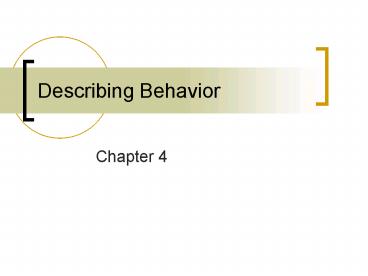Describing Behavior PowerPoint PPT Presentation
Title: Describing Behavior
1
Describing Behavior
- Chapter 4
2
Data Analysis
- Two basic types
- Descriptive
- Summarizes and describes the nature and
properties of the data - Inferential
- What is the likelihood the results in the sample
actually occur in the population - (e.g., differences between groups, relationships
between variables)
3
Describing Individual Differences
- Measures of Central Tendency
- Measures of Variability
- Distribution of the data
4
Measures of Central Tendency
- Mean
- average score of all observations in distribution
- Median
- midpoint of all scores in distribution
- Mode
- most frequently occurring score in distribution
5
Measures of Variability
- Range
- subtract the lowest from the highest score
- Standard Deviation
- measure of the spread of the scores around the
mean - Variance
- square of the standard deviation
6
Calculating the standard deviation
1.58
7
Data Distributions
8
Descriptive Statistics
- Distribution of the data
- Shapes of distribution curves
- Bell (normal distribution)
- The bell curve has desirable statistical
properties - A number of inferential statistics assume data
is normally distributed - Skewed Curves
- Negative Skew - tail of the curve is to the left
- Positive Skew - tail of the curve is to the right
9
Properties of a Normal Distribution
- Measures of central tendency are the same
- mean median mode
- We know percentage of scores that fall within
- ? 1 standard deviation (68)
- ? 2 standard deviations (95)
- ? 3 standard deviations (99)
10
(No Transcript)
11
Correlation
- The extent to which one variable can be
understood on the basis of another - Properties of correlation coefficient
- direction (positive or negative)
- magnitude (strength of the relationship)
12
Positive Correlation
r .95
13
No Correlation
r .00
14
Negative Correlation
High
r -.95
Low
Low
High
15
Correlation A Review
16
Distribution for Example
M 3.00 SD 1.10
PowerShow.com is a leading presentation sharing website. It has millions of presentations already uploaded and available with 1,000s more being uploaded by its users every day. Whatever your area of interest, here you’ll be able to find and view presentations you’ll love and possibly download. And, best of all, it is completely free and easy to use.
You might even have a presentation you’d like to share with others. If so, just upload it to PowerShow.com. We’ll convert it to an HTML5 slideshow that includes all the media types you’ve already added: audio, video, music, pictures, animations and transition effects. Then you can share it with your target audience as well as PowerShow.com’s millions of monthly visitors. And, again, it’s all free.
About the Developers
PowerShow.com is brought to you by CrystalGraphics, the award-winning developer and market-leading publisher of rich-media enhancement products for presentations. Our product offerings include millions of PowerPoint templates, diagrams, animated 3D characters and more.

